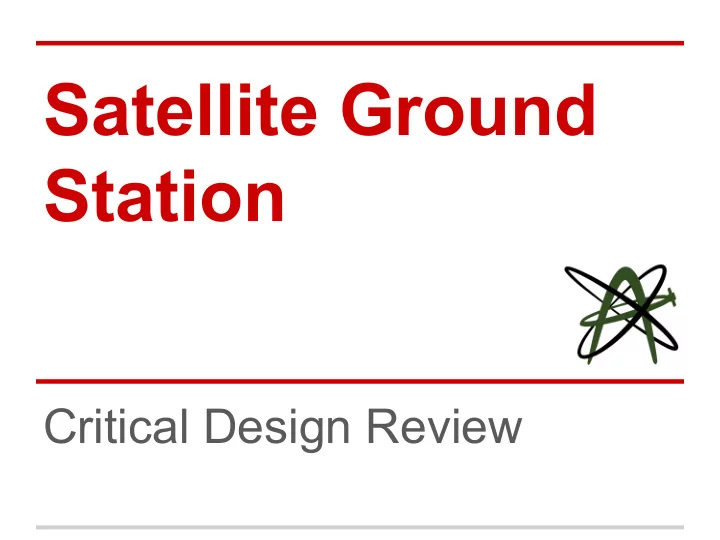

Satellite Ground Station Critical Design Review
Group Composition ● Andrew Keller - Base Station Hardware ● Ranek Kiil - Server and Software ● Jacob Ortt - Satellite Communications ● Bryson Peeters - Project Lead
Motivation Automated and integrated solution to track satellite and communicate with it. ● Point antenna at satellite ● Tune radio to satellite’s frequency ● Store and decode signals from space ● Send commands to satellite when it passes ● Provide public interface to stored data
Hardware Overview ● 70cm Yagi-Uda Antenna kenwood-electronics.co.uk Satellite Antenna ● Circular Polarization ● Half-Duplex Communication ● Kenwood TS-2000 ● Filters signals from Antenna Radio ● Sends broadcast signal ● Terminal Node Controller ● Modulates outgoing data TNC ● Demodulates incoming data hamradio.com ● Linux based server terminal ● Accessible from Internet Main PC ● Implements Software Component hamtv.com ● Alfa MD-01 Controller ● Controls the speed of the Controller Rotor and alignment of the Antenna. ● AlfaSpid BIG RAS/HR Rotator alfaradio.ca alfaradio.ca ● Rotates the Antenna to follow the satellite orbit.
Unified Overview AlbertaSat Ground Station Satellite Rotator Internet Altitude & Controller azimuth Main Sat to Ground: Controls Housekeeping libastro Time Satellite & Payload Tracker Data Prediction Keplerian Rotator Engine HamLib Ground to Sat: Elements FreeRTOS Commands Antenna Comm drivers Web UI Coaxial cable Public Antenna Radio Tuning Storage frequency Processing Audio QB50 Other & Analysis Satellites Beacons & Terminal Data Housekeeping Node Data Controller Communications Simulation Satellite
Challenges / Design Calculations ● Doppler effect on Tx and Rx frequencies ● Interfacing between software components of the ground station and satellite itself. ● Testing with temporary, non-ideal installation. ● Continuous rotation of the rotor is impractical so intervals must be timed to catch the rising edges of the satellite transmission. ● Understanding antenna polarization
Code Example import numpy import ephem import datetime import requests import dateutil def loadTLE(data): """ Loads a TLE file and creates a list of satellites.""" f = data.splitlines() # Chunk by three-line sets satellites = [f[i:i+3] for i in range(0, len(f), 3)] # Iterate through and add to dictionary satellite_list = {} for satellite_lines in satellites: satellite_lines = map(str, satellite_lines) satellite_list[satellite_lines[0].strip()] = satellite_lines return satellite_list
Code Example # Define rooftop at the University of Alberta Campus rooftop = ephem.Observer() # These figures currently approximate CCIS Observatory rooftop.lat = numpy.deg2rad(53.528) rooftop.lon = numpy.deg2rad(-113.527) rooftop.elevation = 700 # Calculations are relative to today rooftop.date = datetime.datetime.utcnow() # Load Keplerian Elements tle_data = requests.get("http://www.celestrak.com/NORAD/elements/cubesat.txt") satellites = loadTLE(tle_data.text) satellite_lines = satellites["QB50P2"] satellite = ephem.readtle(*satellite_lines)
Code Example # Calculate the next pass info = rooftop.next_pass(satellite) rise_time = info[0].datetime() transit_time = info[2].datetime() set_time = info[4].datetime() pass_time = (set_time - rise_time).seconds lt = ephem.localtime(info[2]) print("Next rise at %s, set at %s, transit at %s, pass duration %s seconds." % (rise_time, set_time, transit_time, pass_time)) # Make a range of times every second for the duration of the pass times = [rise_time - datetime.timedelta(seconds=5) + datetime.timedelta(seconds=x) for x in range(0, pass_time + 10)] # Compute satellite locations at each datetime altitudes, azimuths = [], [] for date in times: rooftop.date = date satellite.compute(rooftop) altitudes.append(numpy.rad2deg(satellite.alt)) azimuths.append(numpy.rad2deg(satellite.az))
Test Plan ● Communication protocol tested using simple RS-232 ● Weather satellites for testing of tracking ● Two “precursor” cube-sat satellites for testing receipt of beacons and housekeeping data ● ISS for testing transmission
Feature Priority ● Prediction Engine ● Rotator Controls ● Communications Link (Ground Station) ● Data Processing and Analysis ● Web UI Optional: ● Communications Link (Satellite) ● Communications with other university satellites in the program
Questions?
Recommend
More recommend